





Waiting My Turn – Social Story for Patience and Taking Turns
₹80
₹160
50% off
0 (0 ratings)
Grade Levels
Pre-K - Grade 2 (Ages 3-8)
Content Overview
Format: Printable PDF, Total Pages: 11, Features: 16 real-life segments, engaging illustrations, 6 interactive activities
Categories
Pages from the Resource
Teach children the importance of waiting their turn with this engaging social story. Using real-life scenarios, first-person storytelling, and interactive activities, kids develop patience, self-regulation, and turn-taking skills. Perfect for preschoolers, kids with autism, ADHD, and social-emotional learning (SEL).

Page 1

Page 2
What Users Say
0
0 ratings
5
0+
4
0+
3
0+
2
0+
1
0+
5 Stars
Product is Good to use.
9 months ago
Varsha Parent
Similar Products
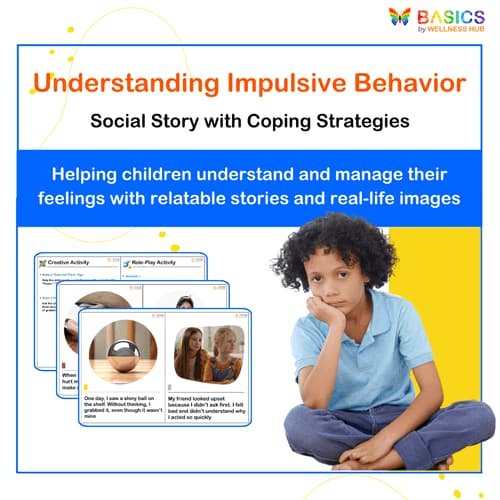
Understanding Impulsive Behavior: Social Story with Coping Strategies
₹ 80.00
₹ 160.00
50% off
4.9 (42 ratings)
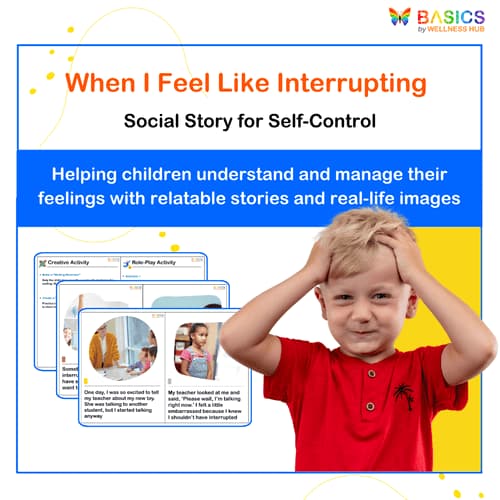
When I Feel Like Interrupting – Social Story for Self-Control
₹ 80.00
₹ 160.00
50% off
4.8 (60 ratings)
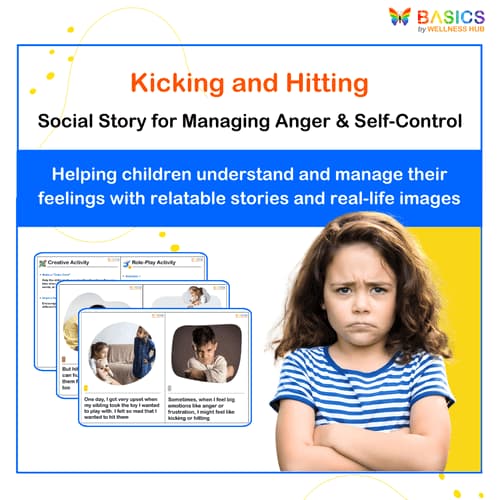
Kicking and Hitting – Social Story for Managing Anger & Self-Control
₹ 80.00
₹ 160.00
50% off
4.6 (52 ratings)
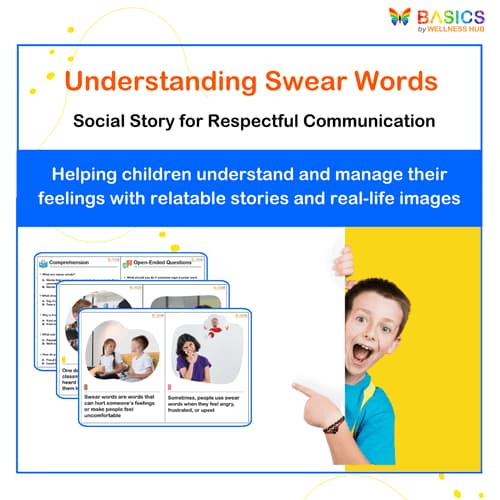
Understanding Swear Words – Social Story for Respectful Communication
₹ 80.00
₹ 160.00
50% off
4.9 (48 ratings)
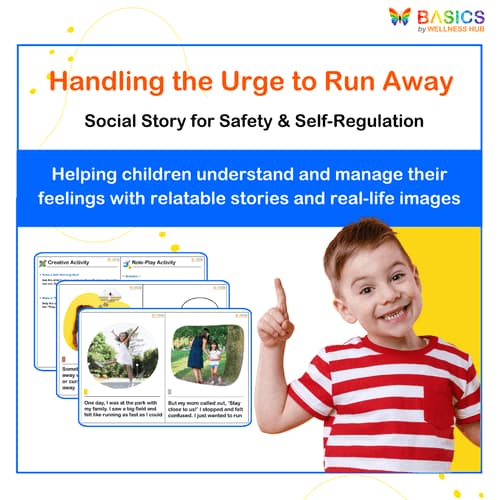
Handling the Urge to Run Away – Social Story for Safety & Self-Regulation
₹ 80.00
₹ 160.00
50% off
4.8 (44 ratings)
About the Product
Teaching children how to wait their turn is a crucial social skill that helps them navigate interactions at school, at home, and in social settings. Many young children struggle with impulsivity and patience, especially in group activities, conversations, and playtime.
This printable social story is designed to help children understand why waiting their turn is important and how to manage their emotions while waiting. By using a first-person storytelling approach, children can relate to real-life situations where turn-taking is necessary, making the learning process engaging and meaningful.
This resource is ideal for:
✔ Preschoolers and early learners who need guidance in developing patience and social awareness.
✔ Children with autism, ADHD, and social-emotional challenges who may find waiting difficult.
✔ Parents, educators, and therapists looking for a structured way to teach self-regulation and turn-taking.
Product Details
- Format: Printable PDF
- Total Pages: 11
- Segments: 16 real-life scenarios that teach patience and turn-taking.
- Features:
✔ Engaging illustrations to reinforce learning.
✔ First-person storytelling for better emotional connection.
✔ 6 interactive activities to reinforce concepts and encourage practice.
✔ Clear, simple language for young learners.
✔ Real-life situations where turn-taking is essential (e.g., playground, classroom, family settings).
This ready-to-use resource is perfect for classrooms, therapy sessions, and home learning environments.
Educational Benefits
This social story is more than just a story—it’s a powerful learning tool that helps children develop essential social-emotional skills.
1. Teaches Patience & Self-Regulation
Children learn why waiting is important, how it impacts others, and how to manage their feelings when they have to wait.
2. Builds Social Skills & Positive Communication
By practicing turn-taking in different scenarios, kids learn to respect others, listen attentively, and engage in cooperative play and conversations.
3. Supports Children with Special Needs
This resource is especially beneficial for children with autism, ADHD, and other developmental challenges. It provides a structured way to teach self-regulation and reduces frustration in social settings.
4. Reinforces Learning with Interactive Activities
Beyond just reading, children can apply their learning with six hands-on activities that encourage discussion, role-playing, and problem-solving.
Instructions for Use
This social story is designed for flexible use at home, in classrooms, or in therapy settings. Here’s how to make the most of it:
1. Read & Discuss the Story
- Start by reading the story aloud with your child or student.
- Ask open-ended questions to encourage discussion:
"Why is waiting important?"
"How do you feel when you have to wait?"
"What can we do to stay calm while waiting?"
2. Use Visual & Real-Life Examples
- Point out situations where turn-taking is necessary in daily life (e.g., waiting in line, sharing a toy, talking in a group).
- Encourage children to observe and identify moments when they successfully wait their turn.
3. Practice with Interactive Activities
- Use the included six activities to reinforce the story’s lessons.
- Activities include:
✔ Vocabulary practice – Understanding key words related to patience.
✔ Spelling activity – Strengthening language skills.
✔ Comprehension questions – Checking understanding of the story.
✔ Open-ended discussion – Encouraging personal reflections.
✔ Creative activity – Drawing or role-playing a scenario where they practice patience.
✔ Role-Play Activity – Acting out turn-taking situations to build confidence.
4. Reinforce the Concept Daily
- Gently remind children to use their "waiting skills" in everyday situations.
- Praise them when they successfully wait their turn:
"Great job waiting for your turn to speak!"
"I love how patient you were in line today!"
Activities Using the Resource
To maximize engagement and help children internalize the concept of waiting their turn, here are interactive activities that pair with this social story:
1. Role-Playing Turn-Taking Scenarios
Objective: Help children apply the concept of waiting their turn in real-life settings.
✔ Materials: Simple props (toys, a pretend microphone for conversation practice, board games).
✔ How to Play:
- Set up a scenario (e.g., waiting for a turn at the swing, raising a hand before speaking, waiting in line).
- Have children act out the correct behavior.
- Reinforce positive behavior with verbal praise: "I love how you waited your turn!"
- Switch roles and allow children to guide the next turn-taking scenario.
2. "Patience Jar" – Visual Reinforcement Activity
Objective: Teach delayed gratification and encourage self-regulation.
✔ Materials: A clear jar, small pom-poms or tokens.
✔ How to Play:
- Each time a child waits their turn successfully, add a token to the jar.
- Once the jar is full, reward the child with a small prize (e.g., choosing a story, extra playtime).
- This helps visualize progress and makes learning more rewarding.
3. "What Would You Do?" Discussion Cards
Objective: Improve decision-making skills in social situations.
✔ Materials: Printable scenario cards (write different turn-taking dilemmas).
✔ How to Play:
- Read a scenario aloud (e.g., "You’re in class, and you really want to answer, but your teacher is helping someone else. What do you do?").
- Let the child think and respond with what they would do.
- Discuss the best approach using the lessons from the social story.
4. "Wait for It" – A Fun Timing Game
Objective: Reinforce patience with a fun challenge.
✔ Materials: A timer or stopwatch.
✔ How to Play:
- Start a simple task, like building a tower with blocks.
- Set a waiting time (e.g., "Before you add a block, wait 10 seconds!").
- Gradually increase the waiting time to improve self-control.
5. Storytelling with Personalized Scenarios
Objective: Help kids relate the concept to their own experiences.
✔ Materials: Drawing sheets, crayons, or a blank worksheet.
✔ How to Play:
- Ask the child to draw and describe a time when they had to wait their turn.
- Encourage them to share their feelings and how they handled it.
- Reinforce positive waiting strategies from the social story.
FAQs
Q1. Who is this social story designed for?
This resource is suitable for all young children (ages 3-8 years) who need support in learning patience, turn-taking, and self-regulation. It’s especially beneficial for:
✔ Children with autism, ADHD, and social-emotional challenges who struggle with impulsivity.
✔ Preschoolers and early learners developing social interaction skills.
✔ Parents, teachers, and therapists looking for structured tools to teach waiting skills.
Q2. How do I use this social story effectively?
To make the most of this resource:
✔ Read the story regularly – Repetition helps children internalize the lesson.
✔ Discuss each scenario – Ask questions to check understanding and encourage reflection.
✔ Use the interactive activities – Reinforce the lesson with role-playing and fun exercises.
✔ Praise and reward patience – Positive reinforcement encourages long-term learning.
Q3. Can this be used in therapy sessions?
Yes! This social story is an excellent tool for speech therapists, behavioral therapists, and special educators. It can be incorporated into individual or group therapy sessions to practice patience, social turn-taking, and self-regulation.
Q4. Does this resource include any interactive activities?
Yes! In addition to the 16 real-life scenarios, it includes 6 structured activities that reinforce the lessons from the story. These help children practice waiting in a fun and engaging way.
Q5. Is this printable, or does it come as a physical book?
This is a printable PDF that you can download instantly. It’s not a physical book, but you can print it out or use it digitally on a tablet for on-the-go learning.
Q6. Can this be used in a classroom setting?
Absolutely! Teachers can:
✔ Use it as a class-wide lesson on patience and turn-taking.
✔ Read it aloud during circle time to discuss social skills.
✔ Incorporate role-play activities into group work.
Q7. How can I reinforce these lessons at home?
Parents can:
✔ Model patience – Show children how to wait in everyday situations.
✔ Praise good behavior – Acknowledge when they wait their turn successfully.
✔ Use visual reminders – Charts, waiting timers, or cue cards can be helpful.
Usage Rights and Restrictions
To ensure ethical use of this resource, please follow these guidelines:
Allowed:
✅ Personal use by parents, educators, and therapists.
✅ Printing multiple copies for your classroom or therapy sessions.
✅ Using digitally on a tablet or computer.
Not Allowed:
❌ Sharing, distributing, or reselling this resource in any format.
❌ Uploading the PDF to online platforms or third-party websites.
❌ Modifying the content for commercial purposes.
If you’d like bulk licensing or school-wide access, please contact us for special permissions.
Conclusion
"Waiting My Turn – Social Story for Kids" is a powerful tool to help children develop patience, self-regulation, and social awareness. With real-life scenarios, engaging illustrations, and interactive activities, children will learn why waiting is important and how to practice it in everyday situations.
By incorporating this social story into daily routines, therapy sessions, and classroom activities, we can support children in becoming more patient, cooperative, and socially confident.
Instant download – Start using it today!
Perfect for home, school, and therapy settings.



